The Autel Ts508 is your go-to solution for comprehensive TPMS (Tire Pressure Monitoring System) management. With advanced features and user-friendly design, the Autel TS508 empowers automotive technicians and enthusiasts alike. Discover how the Autel TS508 from CARDIAGTECH.NET can streamline your workflow and enhance your TPMS service capabilities. Improve efficiency and precision in tire maintenance today.
1. Understanding the Autel TS508 and Its Capabilities
The Autel MaxiTPMS TS508WF is a cutting-edge TPMS diagnostic and service tool designed to revolutionize how automotive professionals handle tire pressure monitoring systems. The Autel TS508 offers unparalleled functionality and ease of use, simplifying complex TPMS tasks and boosting overall productivity. Dive into the myriad capabilities of the Autel TS508, underscoring its importance in modern automotive repair, and discover how CARDIAGTECH.NET brings this innovative tool to your garage.
1.1. What is the Autel TS508?
The Autel TS508 is a state-of-the-art TPMS tool designed to activate all known TPMS sensors, read sensor status, check system health, program Autel MX-sensors, and conduct TPMS relearn procedures. The TS508 is engineered for both speed and precision, making it an invaluable asset for any automotive technician.
1.2. Key Features of the Autel TS508
The Autel TS508 is packed with features that set it apart from other TPMS tools:
- Comprehensive Sensor Activation: Activates all known TPMS sensors, OE sensors and aftermarket sensors.
- TPMS Data Reading: Accurately reads TPMS sensor data, including sensor ID, tire pressure, temperature, and battery status.
- System Diagnostics: Checks TPMS system health and identifies potential issues, ensuring accurate diagnoses.
- MX-Sensor Programming: Programs Autel MX-Sensors to replace faulty or missing sensors.
- Relearn Function: Guides users through TPMS relearn procedures, synchronizing new sensor IDs with the vehicle’s ECU (Engine Control Unit).
- Quick Mode and Advanced Mode: Offers both Quick Mode for basic operations and Advanced Mode for in-depth diagnostics and programming.
- Wi-Fi Updates: Ensures the tool is always up-to-date with the latest vehicle coverage and software enhancements via Wi-Fi.
- OBDII Connectivity: Connects to the vehicle’s OBDII port for enhanced relearn capabilities and ECU data access.
- Exclusive TPMS Status Screen: Displays crucial TPMS information, including ECU sensor ID, sensor ID and ECU ID matching status, DTCs from ECU, and detailed descriptions.
- Tire Type/Pressure Selection: Allows selection of tire type and setting of the correct tire pressure value when TPMS faults are cleared and tires are inflated to the reference pressure.
1.3. Benefits of Using the Autel TS508
The benefits of incorporating the Autel TS508 into your automotive service operations are numerous:
- Enhanced Efficiency: Streamlines TPMS tasks, reducing diagnostic and repair times.
- Improved Accuracy: Provides precise sensor data and system diagnostics, minimizing errors.
- Increased Productivity: Enables technicians to handle a higher volume of TPMS-related jobs.
- Cost Savings: Reduces the need for expensive dealership visits for TPMS services.
- Customer Satisfaction: Ensures vehicles are safe and compliant with TPMS regulations.
- Versatile Use: Suitable for a wide range of vehicles, making it a universal TPMS solution.
1.4. Who Should Use the Autel TS508?
The Autel TS508 is designed for a diverse range of users:
- Automotive Technicians: Professionals in repair shops and service centers.
- Tire Shops: Businesses specializing in tire sales, installation, and maintenance.
- Independent Mechanics: Self-employed mechanics offering mobile or in-shop services.
- Car Dealerships: Service departments needing efficient TPMS tools.
- Enthusiasts and DIYers: Car owners who prefer to handle their vehicle maintenance.
2. Maximizing Efficiency with Quick Mode and Advanced Mode
The Autel TS508 offers two distinct modes of operation—Quick Mode and Advanced Mode—each designed to cater to different levels of TPMS service complexity. Understanding when and how to use these modes can significantly improve your efficiency and accuracy. This section provides a detailed comparison of Quick Mode and Advanced Mode, complete with scenarios where each mode is most beneficial.
2.1. Quick Mode: Streamlined TPMS Operations
Quick Mode is designed for rapid and straightforward TPMS tasks. It is ideal for basic sensor activation, reading sensor data, and performing quick relearn procedures.
- Simplicity: Quick Mode features a simplified interface, guiding users through essential TPMS functions with minimal steps.
- Speed: It is optimized for fast operations, allowing technicians to quickly diagnose and resolve common TPMS issues.
- Ease of Use: Perfect for users who need to perform routine TPMS tasks without extensive diagnostic procedures.
Use Cases for Quick Mode:
- Sensor Activation: Quickly activate TPMS sensors to check their functionality.
- Reading Sensor Data: Retrieve sensor ID, pressure, temperature, and battery status efficiently.
- Direct Relearn: Perform a direct relearn by entering the sensor IDs manually.
2.2. Advanced Mode: In-Depth Diagnostics and Programming
Advanced Mode unlocks the full potential of the Autel TS508, offering comprehensive diagnostic and programming capabilities. It is designed for technicians who need to perform detailed TPMS analysis, advanced relearn procedures, and MX-Sensor programming.
- Comprehensive Diagnostics: Advanced Mode provides detailed TPMS system diagnostics, including reading and clearing DTCs (Diagnostic Trouble Codes).
- Advanced Relearn Procedures: Supports OBDII relearn procedures, ensuring accurate sensor synchronization with the vehicle’s ECU.
- MX-Sensor Programming: Allows users to program Autel MX-Sensors using various methods, including copy by activation, copy by manual input, and auto-create.
Use Cases for Advanced Mode:
- TPMS System Diagnostics: Diagnose complex TPMS issues by reading and clearing DTCs.
- OBDII Relearn: Perform OBDII relearn procedures to synchronize new sensor IDs with the ECU.
- MX-Sensor Programming: Program MX-Sensors to replace faulty sensors or create new sensor IDs.
- Customized Settings: Adjust TPMS settings, such as pressure thresholds and sensor configurations.
2.3. Comparison Table: Quick Mode vs. Advanced Mode
| Feature | Quick Mode | Advanced Mode |
|---|---|---|
| Interface | Simplified | Detailed |
| Speed | Fast | Slower, due to in-depth analysis |
| Ease of Use | Very Easy | Requires more technical knowledge |
| Sensor Activation | Yes | Yes |
| Reading Sensor Data | Yes | Yes |
| Direct Relearn | Yes | Yes |
| DTC Reading/Clearing | No | Yes |
| OBDII Relearn | No | Yes |
| MX-Sensor Programming | Limited (Copy by Activation) | Comprehensive (Copy by Activation, Manual Input, Auto-Create) |
| Best For | Basic TPMS Tasks and Routine Maintenance | Complex Diagnostics, Advanced Programming, and Custom Settings |
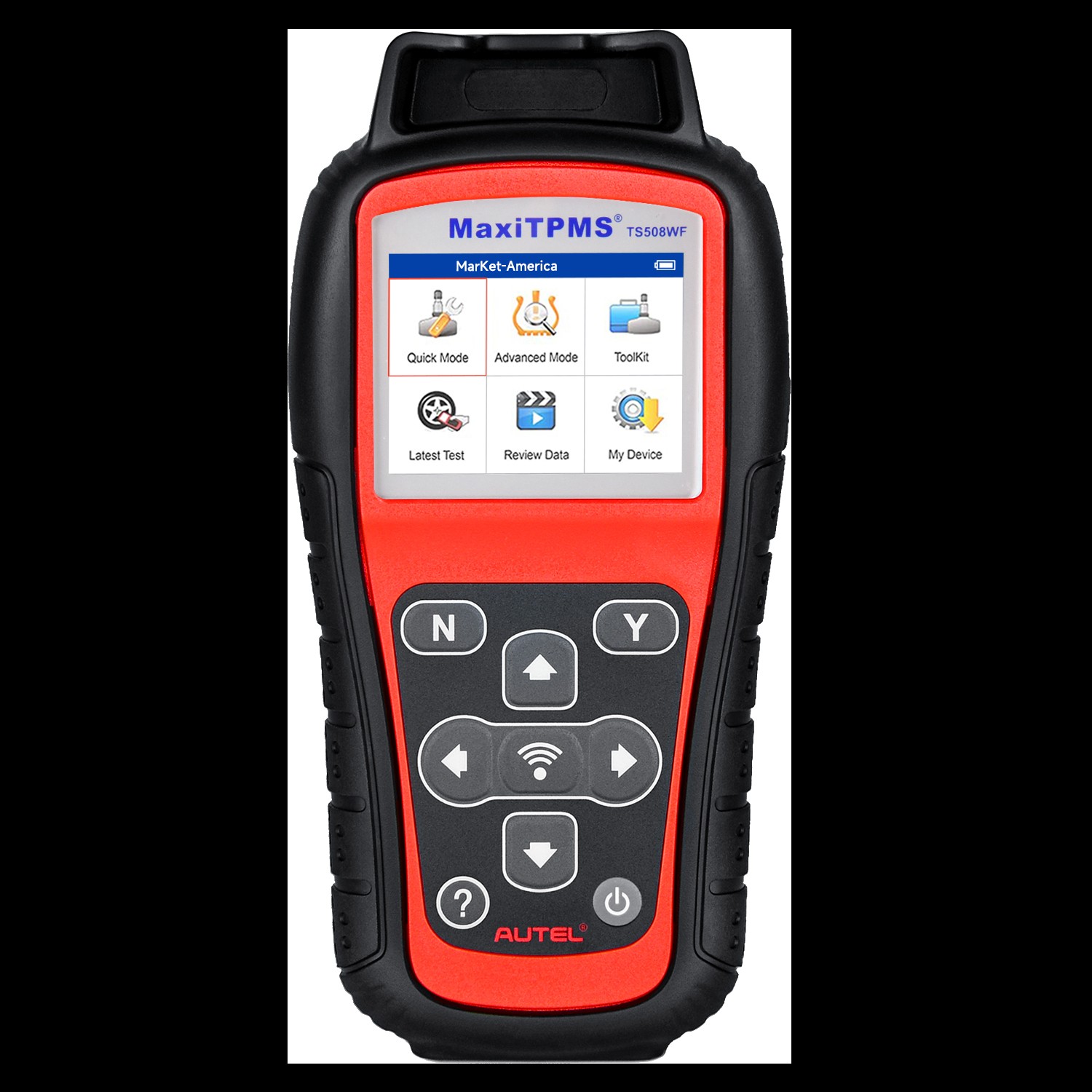
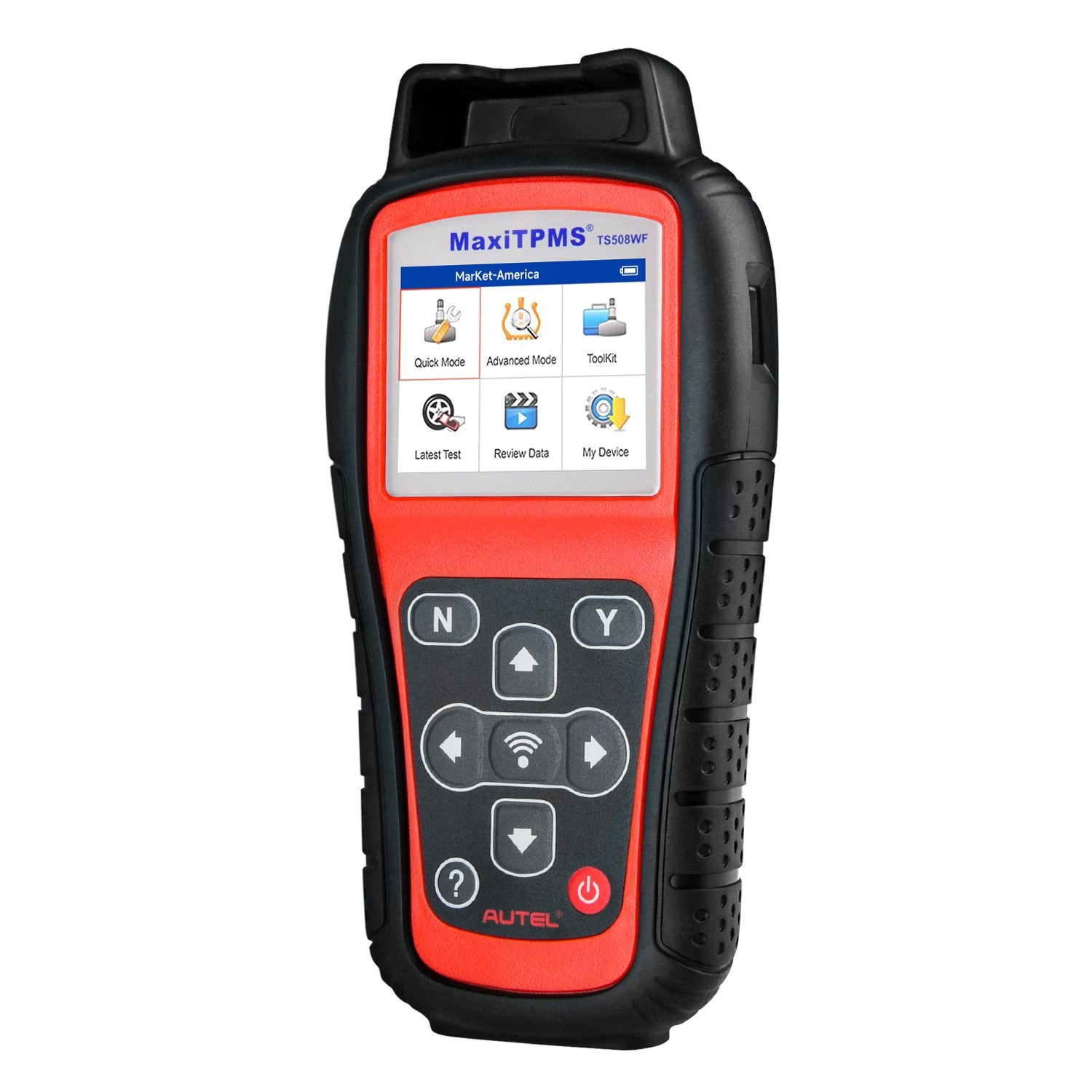
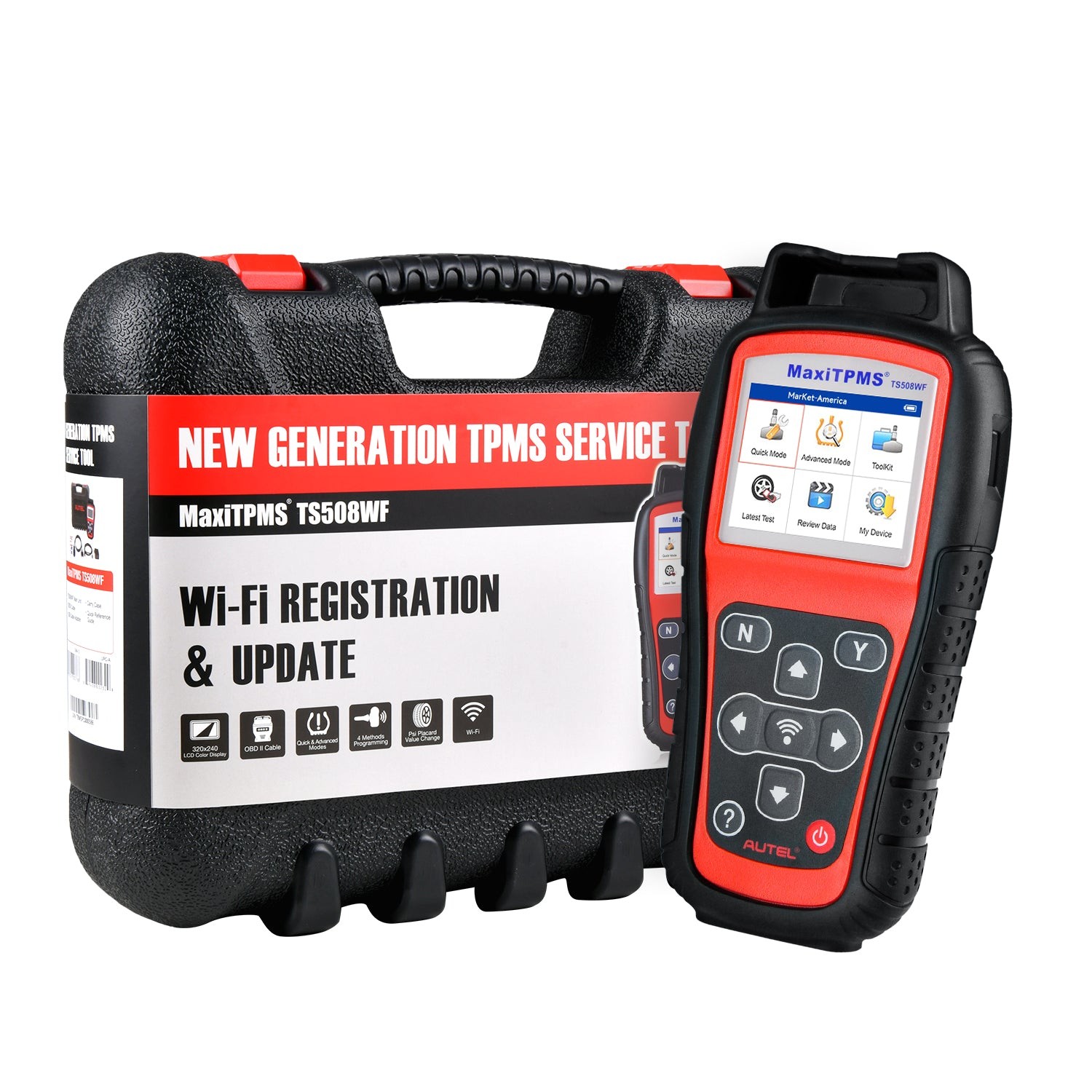
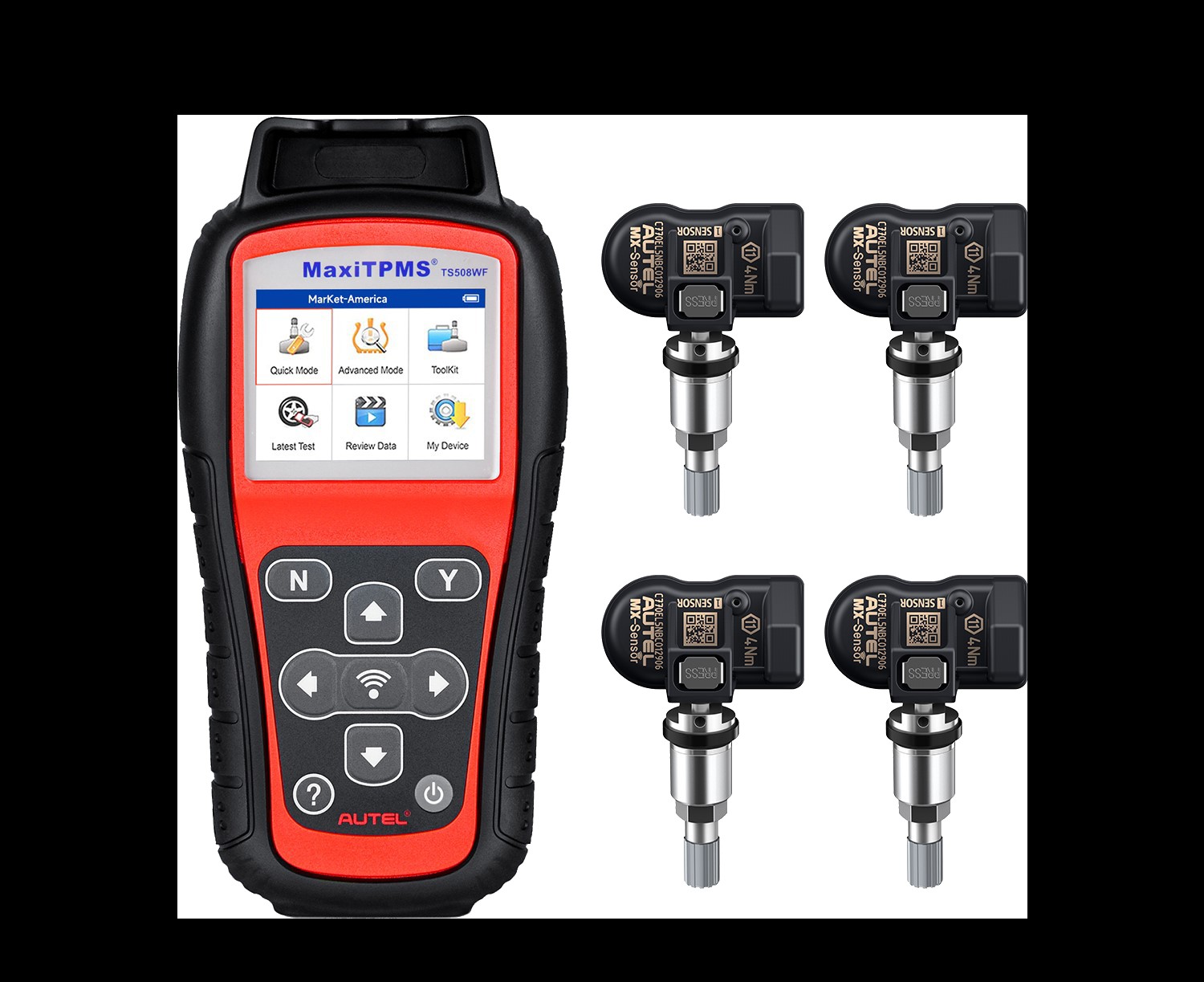

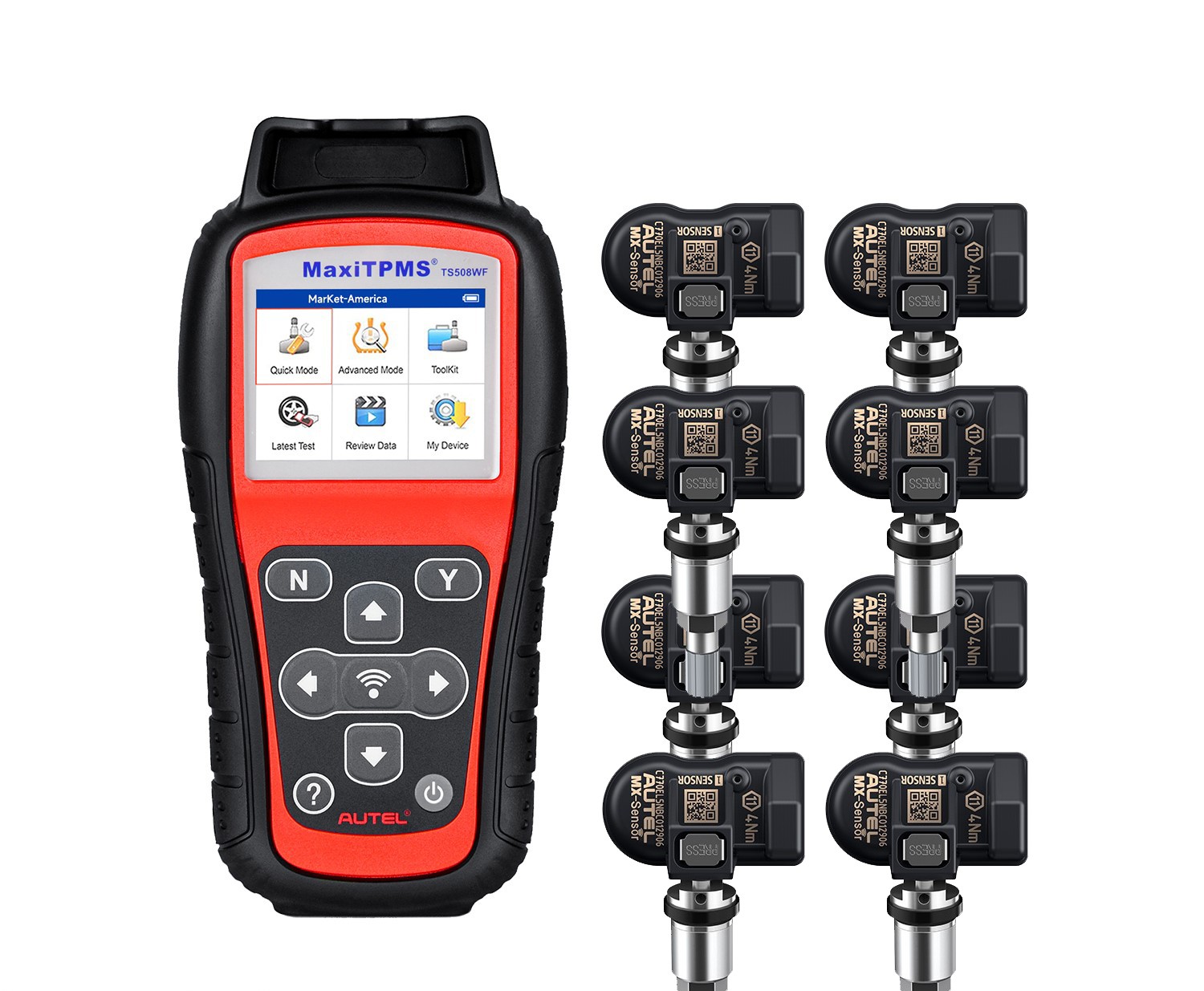
2.4. Practical Scenarios: Choosing the Right Mode
-
Scenario 1: Routine Tire Change
- Task: Activate new sensors and perform a quick relearn.
- Recommended Mode: Quick Mode
- Reason: Quick Mode allows for fast sensor activation and direct relearn, ideal for routine maintenance.
-
Scenario 2: TPMS Warning Light On
- Task: Diagnose the cause of the TPMS warning light and reprogram sensors if necessary.
- Recommended Mode: Advanced Mode
- Reason: Advanced Mode enables comprehensive diagnostics with DTC reading and clearing, along with advanced relearn procedures and MX-Sensor programming.
-
Scenario 3: Replacing a Faulty Sensor
- Task: Program a new MX-Sensor to replace a faulty one and perform a relearn.
- Recommended Mode: Advanced Mode
- Reason: Advanced Mode provides versatile programming options for MX-Sensors and supports OBDII relearn for accurate synchronization.
-
Scenario 4: Checking Sensor Status
- Task: Quickly check the status of all TPMS sensors on a vehicle.
- Recommended Mode: Quick Mode
- Reason: Quick Mode efficiently reads sensor data, providing essential information without the need for detailed diagnostics.
3. Unleashing the Power of MX-Sensor Programming
The Autel TS508 offers versatile MX-Sensor programming options, allowing you to replace or duplicate TPMS sensor IDs with ease. The Autel TS508 stands out with its flexible programming methods: Copy by OBD and Auto Create 1-16. These features ensure compatibility across different vehicle models and TPMS requirements, enhancing the efficiency of your TPMS service. Let’s explore each method in detail and understand how they can streamline your workflow.
3.1. Why MX-Sensors?
Autel MX-Sensors are programmable universal sensors designed to replace a wide range of OE (Original Equipment) TPMS sensors. They offer several advantages:
- Wide Compatibility: MX-Sensors are compatible with over 98% of vehicles equipped with TPMS.
- Programmability: They can be programmed to replicate the IDs of existing sensors or to create new, unique IDs.
- Cost-Effectiveness: MX-Sensors are often more affordable than OE sensors, providing a cost-effective solution for TPMS replacement.
- Inventory Management: Reduces the need to stock multiple OE sensors, simplifying inventory management.
3.2. Copy by OBD: Cloning Sensor IDs from the ECU
The Copy by OBD feature allows you to directly write the sensor ID saved in the vehicle’s ECU to a new MX-Sensor. This method is particularly useful when you need to replace a faulty sensor with an MX-Sensor and want to maintain the original sensor ID.
Steps for Copy by OBD:
- Connect the TS508 to the Vehicle: Connect the Autel TS508 to the vehicle’s OBDII port.
- Select Vehicle Information: Enter the vehicle’s make, model, and year in the TS508.
- Read Sensor IDs from ECU: Use the TS508 to read the sensor IDs stored in the ECU.
- Program MX-Sensor: Select the Copy by OBD option and program the MX-Sensor with the retrieved ID.
- Verify Programming: Ensure the MX-Sensor is successfully programmed with the correct ID.
- Install the MX-Sensor: Install the programmed MX-Sensor in the wheel.
- Perform Relearn: Perform a TPMS relearn procedure to synchronize the new sensor ID with the vehicle’s ECU.
Benefits of Copy by OBD:
- Simplified Replacement: Makes sensor replacement straightforward by cloning the original ID.
- No Relearn Required (in Some Cases): Depending on the vehicle, a relearn procedure may not be necessary if the sensor ID is directly copied from the ECU.
- Accuracy: Ensures accurate duplication of sensor IDs, minimizing potential errors.
3.3. Auto Create 1-16: Generating Unique Sensor IDs
The Auto Create 1-16 feature allows the Autel TS508 to automatically generate 1 to 16 unique sensor IDs for MX-Sensors. This method is useful when you cannot retrieve the original sensor IDs or when you need to replace multiple sensors simultaneously.
Steps for Auto Create 1-16:
- Select Vehicle Information: Enter the vehicle’s make, model, and year in the TS508.
- Choose Auto Create Option: Select the Auto Create 1-16 option in the programming menu.
- Generate Sensor IDs: The TS508 will automatically generate the specified number of unique sensor IDs.
- Program MX-Sensors: Program the MX-Sensors with the generated IDs.
- Record Sensor IDs: Note down the generated sensor IDs for the relearn procedure.
- Install the MX-Sensors: Install the programmed MX-Sensors in the wheels.
- Perform Relearn: Perform a TPMS relearn procedure to synchronize the new sensor IDs with the vehicle’s ECU.
Benefits of Auto Create 1-16:
- Versatility: Suitable for situations where original sensor IDs are unavailable.
- Efficiency: Quickly generates multiple unique IDs for simultaneous sensor replacements.
- Comprehensive Solution: Ideal for vehicles requiring a complete set of new TPMS sensors.
3.4. Practical Examples: When to Use Each Programming Option
-
Scenario 1: Replacing a Single Faulty Sensor
- Recommended Method: Copy by OBD
- Reason: Copy by OBD allows you to clone the ID from the ECU, simplifying the replacement process and potentially eliminating the need for a relearn.
-
Scenario 2: Replacing All Four Sensors
- Recommended Method: Auto Create 1-16
- Reason: Auto Create 1-16 quickly generates unique IDs for all four sensors, making it efficient for complete sensor replacement.
-
Scenario 3: Sensor ID Unknown or Unreadable
- Recommended Method: Auto Create 1-16
- Reason: When the original sensor ID cannot be retrieved, Auto Create 1-16 provides a solution by generating new, unique IDs.
-
Scenario 4: Maintaining Original Sensor IDs
- Recommended Method: Copy by OBD
- Reason: If maintaining the original sensor IDs is crucial (e.g., for specific vehicle requirements), Copy by OBD ensures accurate duplication.
4. Staying Up-to-Date with Wi-Fi Updates
Keeping your Autel TS508 updated is crucial for optimal performance, ensuring you have the latest vehicle coverage, software enhancements, and bug fixes. The TS508 offers two convenient update methods: Wi-Fi and USB. This section focuses on the advantages of Wi-Fi updates and provides a step-by-step guide to keep your tool up-to-date.
4.1. Benefits of Wi-Fi Updates
- Convenience: Update your TS508 directly without needing a computer.
- Speed: Wi-Fi updates are generally faster than USB updates, saving you time.
- Accessibility: Update from anywhere with a Wi-Fi connection.
- Real-Time Updates: Receive notifications for new updates as soon as they are available.
4.2. Step-by-Step Guide to Updating via Wi-Fi
-
Connect to Wi-Fi:
- Power on your Autel TS508.
- Navigate to the Settings menu.
- Select Wi-Fi and choose your network.
- Enter the Wi-Fi password if required and connect to the network.
-
Check for Updates:
- Go back to the main menu and select Update.
- The TS508 will automatically check for available updates.
-
Download and Install Updates:
- If updates are available, a list will be displayed.
- Select the updates you want to install and tap Download.
- Once the download is complete, tap Install to begin the installation process.
-
Restart the Tool:
- After the installation, the TS508 may prompt you to restart the tool. Follow the on-screen instructions to restart.
-
Verify the Update:
- Go to the Settings menu and select About to verify the software version.
- Ensure the installed version matches the latest available version.
4.3. Troubleshooting Wi-Fi Update Issues
-
No Wi-Fi Connection:
- Ensure your TS508 is within range of the Wi-Fi router.
- Check that the Wi-Fi network is functioning correctly.
- Restart the TS508 and try connecting again.
-
Update Fails to Download:
- Check your Wi-Fi connection speed and stability.
- Ensure there is enough storage space on the TS508.
- Restart the TS508 and try downloading the update again.
-
Update Fails to Install:
- Ensure the TS508 has sufficient battery power or is connected to a power source.
- Close any running applications and try installing the update again.
- Contact Autel support if the issue persists.
4.4. Keeping Your TS508 Updated via USB
Although Wi-Fi updates are more convenient, you can also update your TS508 via USB. Here’s how:
-
Download the Update Software:
- Visit the Autel website and download the Maxi PC Suite to your computer.
- Install the Maxi PC Suite following the on-screen instructions.
-
Connect the TS508 to Your Computer:
- Connect the TS508 to your computer using the provided USB cable.
- Launch the Maxi PC Suite.
-
Update the Tool:
- The Maxi PC Suite will detect your TS508 and check for available updates.
- Follow the on-screen instructions to download and install the updates.
-
Safely Disconnect the Tool:
- Once the update is complete, safely disconnect the TS508 from your computer.
- Restart the TS508 and verify the update.
5. Leveraging the Exclusive TPMS Status Screen
The Autel TS508 features an exclusive TPMS Status Screen designed to provide comprehensive information about the TPMS system at a glance. This screen is a powerful tool for diagnosing and resolving TPMS issues efficiently. Let’s explore the key components of this screen and how to use them effectively.
5.1. Key Components of the TPMS Status Screen
- Read ECU Sensor ID: Displays the sensor IDs currently stored in the vehicle’s ECU.
- Check Sensor ID and ECU ID Matching Condition: Indicates whether the sensor IDs match those stored in the ECU.
- Read DTCs from ECU: Retrieves Diagnostic Trouble Codes (DTCs) related to the TPMS system from the ECU.
- Erase DTCs: Allows you to clear DTCs from the ECU after addressing the underlying issues.
- View DTCs Detail Description: Provides detailed descriptions of the DTCs, helping you understand the nature of the problem.
5.2. Using the TPMS Status Screen for Diagnostics
The TPMS Status Screen is a valuable tool for diagnosing various TPMS issues. Here’s how to use it:
- Connect to the Vehicle: Connect the Autel TS508 to the vehicle’s OBDII port.
- Access the TPMS Status Screen: Navigate to the TPMS Status Screen in the tool’s menu.
- Read ECU Sensor ID: Check the sensor IDs stored in the ECU. Compare these IDs with the actual sensor IDs to identify any discrepancies.
- Check Sensor ID and ECU ID Matching Condition: Verify that the sensor IDs match. If they don’t, it indicates a relearn issue or a mismatched sensor.
- Read DTCs from ECU: Retrieve any DTCs related to the TPMS system. Note down the DTC codes for further investigation.
- View DTCs Detail Description: Select each DTC to view its detailed description. This will help you understand the specific issue and its potential causes.
5.3. Common TPMS Issues and How the Status Screen Helps
-
Issue 1: TPMS Warning Light On
- Status Screen Information: Check for DTCs related to low tire pressure, sensor failure, or communication issues.
- Action: Address the DTCs by inflating tires, replacing faulty sensors, or performing a relearn procedure.
-
Issue 2: Mismatched Sensor IDs
- Status Screen Information: The Sensor ID and ECU ID Matching Condition will indicate a mismatch.
- Action: Perform a TPMS relearn procedure to synchronize the sensor IDs with the ECU.
-
Issue 3: Faulty Sensor
- Status Screen Information: DTCs may indicate a sensor failure.
- Action: Replace the faulty sensor and perform a relearn procedure.
-
Issue 4: Communication Issues
- Status Screen Information: DTCs may indicate communication problems between the sensors and the ECU.
- Action: Check the wiring and connections between the sensors and the ECU. Repair or replace any damaged components.
5.4. Clearing DTCs with the TS508
After addressing the TPMS issues, you can use the Autel TS508 to clear the DTCs from the ECU. Here’s how:
- Address the Underlying Issues: Ensure that all TPMS issues have been resolved, such as inflating tires, replacing faulty sensors, or performing a relearn.
- Access the TPMS Status Screen: Navigate to the TPMS Status Screen in the tool’s menu.
- Select Erase DTCs: Choose the Erase DTCs option to clear the DTCs from the ECU.
- Verify the Clearance: After clearing the DTCs, check the TPMS Status Screen again to ensure that no DTCs are present.
5. Tire Type and Pressure Selection
The Autel TS508 offers a valuable feature that allows you to select the tire type and set the correct tire pressure value. This function is particularly useful when you’ve cleared all TPMS faults, inflated the four tires to the reference pressure listed on the placard, and yet the TPMS MIL (Malfunction Indicator Light) remains on. This section explains how to use this feature effectively.
6.1. Understanding Tire Type and Pressure Selection
- Why It Matters: Selecting the correct tire type and setting the appropriate pressure value ensures that the TPMS system accurately monitors tire conditions. The TPMS relies on these settings to determine when a tire is underinflated or overinflated.
- When to Use: Use this function when:
- All TPMS faults have been cleared.
- The four tires are inflated to the reference pressure listed on the placard (usually found on the driver’s side doorjamb or in the vehicle’s manual).
- The TPMS MIL remains illuminated despite the above steps.
6.2. Step-by-Step Guide to Tire Type and Pressure Selection
-
Access the Function:
- Connect the Autel TS508 to the vehicle’s OBDII port.
- Navigate to the TPMS function menu.
- Select “Tire Type/Pressure Selection.”
-
Select Tire Type:
- The tool will display a list of available tire types. Common options include:
- Standard Tires
- Run-Flat Tires
- Winter Tires
- Choose the tire type that matches the tires currently installed on the vehicle.
- The tool will display a list of available tire types. Common options include:
-
Set Tire Pressure Value:
- The tool will prompt you to enter the correct tire pressure value.
- Refer to the vehicle’s placard for the recommended tire pressure.
- Enter the value using the tool’s keypad.
-
Confirm the Settings:
- Review the selected tire type and pressure value to ensure they are correct.
- Confirm the settings to save them to the vehicle’s TPMS system.
-
Verify TPMS MIL Status:
- After saving the settings, check the TPMS MIL on the dashboard.
- The light should turn off if the settings were successfully applied and there are no other underlying TPMS issues.
6.3. Practical Tips for Accurate Selection
- Consult the Placard: Always refer to the vehicle’s placard for the recommended tire pressure. This ensures you are using the manufacturer’s specified values.
- Check the Tire Sidewall: Verify the tire type by checking the sidewall markings on the tires.
- Consider Seasonal Changes: If you switch to winter tires, be sure to update the tire type in the TPMS settings accordingly.
- Document Changes: Keep a record of any changes made to the TPMS settings for future reference.
6.4. Benefits of Proper Tire Type and Pressure Selection
- Accurate TPMS Monitoring: Ensures the TPMS system accurately monitors tire conditions, providing timely warnings for underinflation or overinflation.
- Improved Safety: Helps maintain optimal tire pressure, enhancing vehicle handling, braking, and overall safety.
- Extended Tire Life: Proper tire pressure reduces wear and tear, extending the lifespan of your tires.
- Fuel Efficiency: Correctly inflated tires improve fuel efficiency, saving you money on gas.
7. Real-World Applications and Case Studies
To fully appreciate the capabilities of the Autel TS508, let’s examine some real-world applications and case studies where this tool has made a significant impact. These examples highlight the versatility and efficiency of the TS508 in various automotive service scenarios.
7.1. Case Study 1: Tire Shop Efficiency
-
Scenario: A busy tire shop needs to quickly and accurately service TPMS-equipped vehicles.
-
Challenge: The shop faces high volumes of customers and needs to minimize service times while ensuring accuracy.
-
Solution: The shop invests in the Autel TS508 and trains its technicians to use Quick Mode for routine tasks.
-
Results:
- Reduced Service Times: Quick Mode allows technicians to activate sensors, read data, and perform relearns in a fraction of the time compared to manual methods.
- Increased Throughput: The shop can service more vehicles per day, boosting revenue.
- Improved Accuracy: The TS508’s precise data reading minimizes errors, leading to fewer comebacks.
7.2. Case Study 2: Independent Mechanic Diagnostics
-
Scenario: An independent mechanic encounters a vehicle with a persistent TPMS warning light.
-
Challenge: The mechanic needs to diagnose the root cause of the issue and resolve it efficiently.
-
Solution: The mechanic uses the Autel TS508 in Advanced Mode to perform comprehensive diagnostics.
-
Results:
- Accurate Diagnosis: The TS508 identifies a faulty sensor and a communication issue between the sensor and the ECU.
- Efficient Repair: The mechanic replaces the faulty sensor, repairs the wiring, and performs an OBDII relearn.
- Customer Satisfaction: The vehicle owner is pleased with the quick and accurate resolution of the TPMS issue.
7.3. Case Study 3: Car Dealership TPMS Service
-
Scenario: A car dealership needs to provide TPMS services for a variety of vehicle makes and models.
-
Challenge: The dealership requires a versatile tool that can handle different TPMS systems and sensor types.
-
Solution: The dealership equips its service department with the Autel TS508 and MX-Sensors.
-
Results:
- Versatile Coverage: The TS508’s wide vehicle coverage and MX-Sensor compatibility allow the dealership to service virtually any TPMS-equipped vehicle.
- Simplified Inventory: MX-Sensors reduce the need to stock multiple OE sensors, streamlining inventory management.
- Enhanced Service Quality: The dealership provides high-quality TPMS services, enhancing customer satisfaction and loyalty.
7.4. Real-World Applications in Different Industries
The Autel TS508 is valuable in various industries beyond traditional automotive service:
- Fleet Management: Fleet managers use the TS508 to maintain the TPMS systems of their vehicles, ensuring optimal tire pressure for safety and fuel efficiency.
- Commercial Vehicle Repair: Repair shops specializing in commercial vehicles use the TS508 to service TPMS systems on trucks, buses, and other large vehicles.
- Government and Municipal Services: Government agencies and municipal services use the TS508 to maintain the TPMS systems of their vehicles, ensuring compliance with safety regulations.
8. Why Choose CARDIAGTECH.NET for Your Autel TS508?
When it comes to purchasing your Autel TS508, choosing the right supplier is crucial. CARDIAGTECH.NET offers a range of compelling reasons to make us your trusted partner. We provide not only the Autel TS508 but also exceptional customer support, competitive pricing, and a commitment to your success. Discover why CARDIAGTECH.NET is the preferred choice for automotive professionals and enthusiasts alike.
8.1. Expert Guidance and Support
At CARDIAGTECH.NET, we pride ourselves on providing expert guidance and support to our customers. Our team of knowledgeable professionals is available to answer your questions, provide technical assistance, and help you get the most out of your Autel TS508.
8.2. Competitive Pricing and Value
We offer competitive pricing on the Autel TS508, ensuring you get the best value for your investment. Additionally, we frequently run promotions and discounts, making it even more affordable to equip your shop with this essential tool.
8.3. Genuine Autel Products
When you purchase from CARDIAGTECH.NET, you can be confident that you are receiving a genuine Autel product. We are an authorized Autel distributor, and we stand behind the quality and authenticity of our products.
8.4. Fast Shipping and Delivery
We understand that time is of the essence when it comes to your business. That’s why we offer fast shipping and delivery, ensuring you receive your Autel TS508 as quickly as possible.
8.5. Comprehensive Warranty and Support
Your purchase of the Autel TS508 from CARDIAGTECH.NET is backed by a comprehensive warranty. If you encounter any issues with your tool, our support team is here to assist you with troubleshooting and repairs.
8.6. Commitment to Customer Satisfaction
At CARDIAGTECH.NET, customer satisfaction is our top priority. We are committed to providing you with an exceptional experience, from your initial inquiry to ongoing support and service.
9. Frequently Asked Questions (FAQ) About the Autel TS508
9.1. What vehicles are compatible with the Autel TS508?
The Autel TS508 is compatible with over 98% of TPMS-equipped vehicles, including passenger cars, trucks, SUVs, and vans. It supports a wide range of makes and models from domestic, Asian, and European manufacturers.
9.2. Can the Autel TS508 program non-Autel sensors?
No, the Autel TS508 can only program Autel MX-Sensors. It is not designed to program sensors from other manufacturers.
9.3. How often should I update the Autel TS508?
It is recommended to update the Autel TS508 regularly, ideally whenever a new update is available. This ensures you have the latest vehicle coverage, software enhancements, and bug fixes.
9.4. Does the Autel TS508 require a subscription for updates?
No, the Autel TS508 includes lifetime free updates, so you don’t have to worry about recurring subscription fees.
9.5. Can the Autel TS508 read tire pressure in real-time?
Yes, the Autel TS508 can read tire pressure in real-time, providing you with accurate and up-to-date information about tire conditions.
9.6. What is the warranty period for the Autel TS508?
The Autel TS508 comes with a one-year warranty, protecting you against manufacturing defects and malfunctions.
9.7. Does the Autel TS508 come with MX-Sensors?
The Autel TS508 is typically sold as a standalone tool, but CARDIAGTECH.NET offers bundle packages that include MX-Sensors for added convenience.
9.8. Can the Autel TS508 perform a TPMS relearn on all vehicles?
The Autel TS508 supports various relearn procedures, including OBDII relearn, auto relearn, and manual relearn. However, the specific relearn procedure required may vary depending on the vehicle make and model.
9.9. How do I access the TPMS Status Screen on the Autel TS508?
To access the TPMS Status Screen, connect the Autel TS508 to the vehicle’s OBDII port, navigate to the TPMS function menu, and select TPMS Status.
9.10. What do I do if the Autel TS508 is not connecting to Wi-Fi?
Ensure that your TS508 is within range of the Wi-Fi router, check that the Wi-Fi network is functioning correctly, and restart the TS508. If the issue persists, contact Autel support for assistance.
10. Call to Action: Get Your Autel TS508 Today
The Autel TS508 is more than just a TPMS tool; it’s an investment in efficiency, accuracy, and customer satisfaction. Don’t let outdated TPMS tools hold you back. Upgrade to the Autel TS508 and experience the difference.
Are you ready to take your automotive service to the next level? Contact CARDIAGTECH.NET today to learn more about the Autel TS508 and how it can benefit your business. Our team of experts is here to answer your questions and help you find the perfect solution for your needs.
Contact Information:
- Address: 276 Reock St, City of Orange, NJ 07050, United States
- WhatsApp: +1 (641) 206-8880
- Website: CARDIAGTECH.NET
Don’t wait! Reach out to CARDIAGTECH.NET now and discover how the Autel TS508 can transform your TPMS service operations.
We understand the challenges you face: the physical demands, the constant need to update your skills, and the pressure to deliver fast, accurate service
